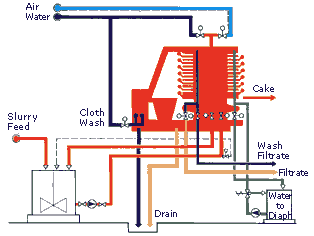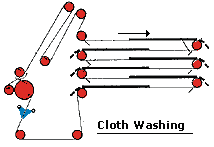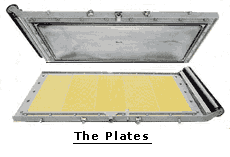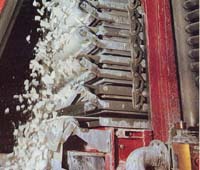
|
Click on the
thumbnail to maximize the image |
The Automatic Pressure Filter was introduced in the mid 70's when the prices of oil have risen sharply and the requirement for extremely dry cakes became inevitable. The early filters were quite small and were introduced mainly in the fine chemicals industry but within a few years they gained popularity in the more robust mineral processing and ore beneficiation industries replacing the conventional vacuum disc filters. As the demand for higher throughputs has gone up also filtration areas have increased and presently large machines with up to 150 m2 handling 120-150 TPH of concentrates and minerals are manufactured.

With such high tonnages the low moisture content became a prime condition for trucking, railing or shipping economically the beneficiated ores over hundreds of miles for smelting. Furthermore, with such bulky loads any excess moisture may cause them to shift when transported by sea so standards of Transportable Moisture Limits were issued for the various dewatered minerals to comply with safety requirements. All these factors are the main reason that the Automatic Pressure Filters are gradually increasing their share in the megaton industries.
The filter, also called Automatic Tower Filterpress, is a semi continuous machine as opposed to conventional filterpresses or any other pressure filter such as candle, horizontal plates or vertical leaf filter that are operating in batches. They may operate on a cycle time as low as 6-7 minutes which is, with the exception of pressure drum filters, the nearest to a continuous filtration cycle.
The Automatic Pressure Filter resembles to some extent filterpresses but with plates that are stacked horizontally to form a tower thus changing the direction of filtration from horizontal to vertical. The vertical design saves floor area and filters having 150 m2 fit in less than 90 m2 but do require a headroom to suit a height of 6 meters.
The detailed sequence of operation is described below but briefly the plates form chambers into which the slurry is fed under pressure to the gap between a rubber diaphragm and the cloth woven filtering belt. Once a cake is formed the diaphragm squeezes the cake to remove the residual moisture prior to washing, if required, or cake discharge. At this stage the plates stack is tightly closed and the cloth belt remains stationary. Once the filtration cycle is completed the stack opens, the cloth indexes one pitch forwards and the dewatered cake moves over rollers and discharges to chutes for further processing.
The operating pressure during slurry feeding (called "pumping" on Automatic Pressure Filters) is 8 bar and during cake squeezing 16 bar.
Materials of construction are stainless steel and polypropylene for all wetted parts in contact with slurry, cake or filtrate so they are also suitable for corrosive applications. The diaphragms in the chambers are made in natural rubber, SBR or butyl.
The filters may be shipped fully assembled in sizes of up to 80 m2 but larger filters require assembly on site.
The Automatic Pressure Filter consists of the following major components:
The Frame
The frame consists of a sturdy structure that supports the plate stack and the two hydraulic rams that keep the plates closed during the entire filtration cycle and open them prior to cake discharge. For maximum safety special wedges ensure that the stack is positively locked during the filtration cycle and are then automatically released to allow the down movement of the rams for cake discharge. The frame also supports the cloth tensioning and aligning roll as well as the cloth washing manifolds that use high impact nozzles to dislodge entrained particles from both sides of the cloth.

|
The Filter Cloth The filtering cloth serves for both filtration and the conveying of the dewatered cake towards the discharge chute at the end of the cycle. It is normally supplied with a 1.5-2.0 mm thick polypropylene which is densely woven and sufficiently strong to take the longitudinal stresses to which the cloth is subjected during cake discharge. The cloth density not only ensures strength but also produces clear filtrates. There are two designs:
|
The chamber consists of two subassemblies:
The plate has two separate connections:
- one for slurry feed and wash water that enter the chamber recess below the diaphragm.
- one for cake squeezing by injecting water under pressure above the diaphragm.

The injection of water inflates the diaphragm into the chamber and the squeeze changes the packing volume of the cake to further remove adhering moisture. The effect of the squeezing is even more noticeable with compressible cakes since the deformation of the particles changes substantially the structure of such cakes.
![]()
Upper Plate Diaphragm Cake Cloth Grid Lower Plate Cake Disch.Belt Cake Disch.Roll To view the components move mouse pointer over the menu
- A lower plate with an inserted polypropylene grid that supports the filtering belt and the formed cake. This plate has a discharge roll at the opposite end to the upper plate roll.
- There are chamber designs that provide for double-sided filtration area of the cloth belt and in this case there are two polypropylene diaphragms that are integral with the plate in a similar way as the membrane plates on filterpresses.
The 150 m2 filters have 24 1.5mx4.0m plates each with a chamber depth of 60
mm and total volume of over 8 m3.
The Ancillaries
The major ancillary required for an Automatic Pressure Filter station is a pump that will inflate the backside of the chambers' diaphragms to the squeezing pressure of 16 bar.
Advantages
Automatic Pressure Filters are best selected in the following instances:

- saving in energy when compared to a vacuum filter-dryer system.
- reducing transport costs when trucking, rail or sea shipping of concentrates.
- conforming to Transportable Moisture Limits safety requirements.
Minimum wash liquid for saving water or reducing effluent flow to disposal.
Low solids content in the filtrate for reducing loss of product or to meet requirements for effluent disposal.
For plants with restricted floor area.
The machine allows the future expansion of filtration area by adding chambers.
The horizontal chambers minimize segregation of fast settling solids contrary to filterpresses where heavy solids settle to the bottom of the vertical plates and form uneven cakes.
The cake lies flat in the chambers so washing is efficient since the wash liquid spreads evenly over the surface of the cake.
Due to the change of direction by the rolls the Automatic Pressure Filters discharge de-lumped cakes so the impact on the downstream conveyor that transports the cake is low. Filterpresses on the other hand discharge the cake in one heavylump that may weigh 200 Kg so special precautions must be taken to protect the rubber belt.
Since the operation of Automatic Pressure Filters is semi continuous the cake conveying facilities may be smaller than those required for filterpresses that discharge in batches.
Disadvantages

| Pumping The plate stack closes and slurry is pumped through flexible pipes each connected to a chamber. As the pressure increases to 8 bar a cake is formed and retained by the filter cloth and the filtrate flows through connections to a manifold for disposal or further processing. This stage, depending on the cake formation time, may take 2 minutes.
|
| Pre-Squeezing Once the chambers are filled water is injected at a pressure of 16 bar to the backside of the diaphragms, the cake is squeezed and its volume decreased. The displaced filtrate flows through the cloth to the collection manifold. The pre-squeezing flattens the surface of the cake and seals cracks to ensure efficient washing. This stage may take 1.5 minutes.
|
| Cake Washing At this point the diaphragms are deflated and wash liquid is introduced through the slurry feed connections to the gap above the cake's surface. The liquid displaces the residual mother filtrate from the cake and the wash filtrate flows through the manifold for disposal or further processing. As required by the process the mother and wash filtrates may be combined or delivered to separate tanks. This stage may take 1 minute.
|
| Squeezing Once cake washing is completed the cake is again squeezed at 16 bar to remove and displace the remaining wash filtrate from the chamber. This stage may take 1.5 minutes.
|
| Cake Drying The diaphragms are now deflated by the introduction of air into the chamber which passes through the compressed cake to provide for maximum removal of adhering moisture. This stage may take 1 minute.
|
| Cake Discharge The plate stack opens and the belt indexes one pitch forwards to discharge the dry cake from both sides of the filter or from one side depending on the design. As cake discharges the moving cloth passes between manifolds with high impact nozzles that dislodge any entrained particles that may clog the cloth. This stage with the opening and closing of the stack may take 3 minutes. |
The total cycle time for this sequence is 10 minutes however depending on the characteristics of the cake and the requirement for washing the range can be 6-20 minutes.
Maintenance
The Automatic Pressure Filter requires attention on a regular basis to safety devices and automation features that accompany modern filters.
The major components that require attention are: